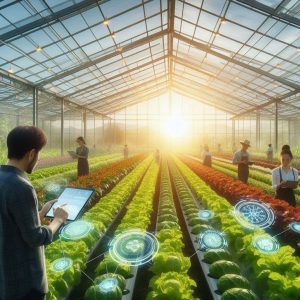Smart agriculture, also known as precision agriculture, leverages modern technology to enhance crop yield, minimize environmental impact, and optimize resource use. It incorporates tools such as GPS, IoT, drones, AI, and data analytics to monitor, measure, and respond to intra-field variability in crops. As global population growth demands increased food production, smart agriculture presents a solution to produce more with less, ensuring sustainability and efficiency in farming practices.
The global smart agriculture market size is projected to reach USD 25.4 billion by 2028 from an estimated USD 16.2 billion in 2023, at a CAGR of 9.4% from 2023 to 2028. This robust growth is attributed to the increasing adoption of technology in agriculture to address challenges such as climate change, soil degradation, and the need for sustainable farming practices.

Download PDF Brochure @ https://www.marketsandmarkets.com/pdfdownloadNew.asp?id=239736790
Factors Driving the Growth of the Smart Agriculture Market
- Technological Advancements: The rapid development of technologies such as the Internet of Things (IoT), artificial intelligence (AI), machine learning, and data analytics has significantly boosted the adoption of smart agriculture practices. These technologies enable real-time monitoring, predictive analysis, and automation in farming.
- Rising Global Food Demand: The world’s population is expected to reach 9.7 billion by 2050, necessitating a significant increase in food production. Smart agriculture offers the tools to enhance productivity and meet this growing demand efficiently.
- Environmental Sustainability: Smart agriculture helps in reducing the environmental footprint of farming by optimizing the use of water, fertilizers, and pesticides, thus promoting sustainable agricultural practices. Precision farming techniques ensure that resources are used judiciously, reducing waste and environmental impact.
- Government Initiatives and Subsidies: Many governments worldwide are promoting smart agriculture through subsidies, grants, and favorable policies. These initiatives aim to encourage farmers to adopt advanced agricultural technologies to boost productivity and sustainability.
- Labor Shortages: The agricultural sector is facing a shortage of skilled labor. Automation and smart farming technologies can fill this gap, reducing the reliance on manual labor and improving efficiency.
Challenges Facing the Smart Agriculture Market
- High Initial Investment: The implementation of smart agriculture technologies requires substantial initial investment. Many small-scale farmers find it challenging to afford these technologies despite their long-term benefits.
- Lack of Awareness and Training: A significant barrier to the adoption of smart agriculture is the lack of awareness and technical expertise among farmers. Training and education programs are essential to bridge this gap.
- Data Privacy and Security: With the increasing use of IoT devices and data analytics, concerns around data privacy and security have intensified. Ensuring the protection of sensitive farm data is crucial.
- Infrastructure Limitations: In many regions, especially in developing countries, inadequate infrastructure such as internet connectivity and power supply can hinder the adoption of smart agriculture technologies.
Future Trends in Smart Agriculture Market
- Integration of AI and Machine Learning: The future of smart agriculture will see deeper integration of AI and machine learning to provide more accurate predictive analytics, enhancing decision-making processes in real-time.
- Expansion of IoT in Agriculture: The use of IoT devices is expected to proliferate, providing farmers with detailed insights into crop health, soil conditions, weather patterns, and more.
- Adoption of Blockchain Technology: Blockchain can enhance transparency and traceability in the agricultural supply chain, ensuring food safety and authenticity.
- Development of Autonomous Farming Equipment: The rise of autonomous tractors, drones, and robotic harvesters will further revolutionize farming, making it more efficient and less labor-intensive.
- Sustainable Practices and Organic Farming: There will be a growing emphasis on sustainable farming practices and organic farming, supported by smart agriculture technologies that enable precise resource management.
Ask for Sample Report @ https://www.marketsandmarkets.com/requestsampleNew.asp?id=239736790
Regional Analysis – Smart Agriculture Market
The smart agriculture market exhibits diverse growth dynamics across regions. North America leads with robust technological infrastructure and government support, fostering high adoption rates, especially in the U.S. and Canada. Europe follows closely, driven by a strong emphasis on sustainability and supportive EU policies, despite market fragmentation. The Asia-Pacific region, particularly China, India, and Japan, shows rapid growth due to rising food demand, government initiatives, and technological advancements, although infrastructure issues persist. Latin America, with Brazil and Argentina at the forefront, focuses on agricultural exports and precision farming, hindered by economic instability and infrastructure deficiencies. The Middle East & Africa, led by Israel and the UAE, adopt smart agriculture to address water scarcity and enhance food security, facing challenges in awareness, raining, and funding.
